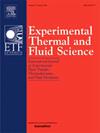Characterizing boiling behaviors in water/ethanol binary droplet impact on a heated plate
Abstract
This work experimentally investigates the transition boiling behaviors of water/ethanol binary droplets impact on a heated smooth aluminum alloy plate with a high-speed imaging system, forming a more finely defined impact behavior regime map. The dynamic Leidenfrost point temperature exhibits a non-monotonic variation trend with ethanol fraction. Binary droplets exhibit two characteristic boiling behaviors at specific temperatures (Ts) and droplet compositions (Φe), including corona boiling and prompt boiling, distinguished by the elevation of a crown-shaped thick liquid lamella and the prompt generation of numerous secondary droplets from the contact line, respectively. Both boiling behaviors are featured with the violent breakup of parent droplet into about 10 or more fragment droplets (secondary droplets with D ≥ 0.3 mm) and the short residence times on the wall, while exhibiting different splash angle distributions of satellite droplets (secondary droplets with D < 0.3 mm). Characteristic parameter analysis of the two boiling behaviors is conducted to provide qualitative mechanistic explanations. Corona boiling occurs at Φe = 25% & 50% with a lower temperature range (Ts ≤ 200 ℃), the liftoff of the liquid layer is attributed to the combined effect of decelerated wetting speed caused by evaporation and the vapor-induced lift. Prompt boiling occurs at Φe = 25% & 50% with Ts ≥ 220 °C and Φe = 75% with Ts < 200 °C, the intensity of the bubble cloud determines whether the central part of the droplet forms a jet or a liquid bulk filled with microbubbles. This work will provide some new insights into the boiling behaviors and the regulation of secondary atomization of binary solution droplets impact studies.

 求助内容:
求助内容: 应助结果提醒方式:
应助结果提醒方式:


